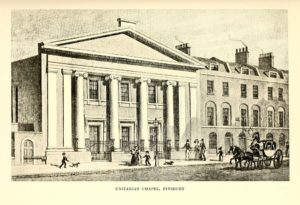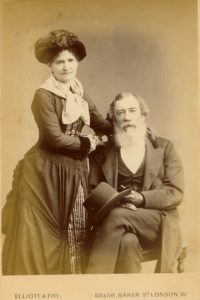American Architects of the UK Humanist Movement

On May 6, 1863, an American abolitionist mounted the platform at South Place Chapel, Finsbury, a London venue long home to religious dissenters and political radicals. Over the following months, he—then still a Unitarian clergyman—would speak at the Chapel sporadically. Before the year’s end, he would accept the ministry there, although “minister” was a title he would soon abandon.
When Virginia-born Moncure Conway (1832–1907) formally agreed to lead the then-faltering congregation at South Place, he began the decades-long relationship which would culminate in its becoming an ethical—and eventually an explicitly humanist—society. Today, London’s Humanist Library is housed in the building which bears his name, built by the South Place Ethical Society in 1929 for a once again flourishing organization.
It had been another American, Elhanan Winchester, who in the late 1700s formed the congregation to which Conway would come a century later. Around him, in a small east London chapel, Winchester had gathered a group who rejected the doctrine of eternal damnation. Conway, speaking in 1893, would describe their more positive ideal of universal redemption as containing within it “an essential spirit and force of humanity which, after the pattern of a new heaven, must inevitably shape the vision of a new earth”. For Conway, this latter practical, provable philosophy was what mattered. He went on:
The present minister of the South Place Society claims no literal continuity with the particular doctrines of his predecessors, though he believes that their spirit has animated the changes it has undergone.
When a series of lectures given by another American in 1887 prompted South Place’s committee to seek his permanent appointment, Conway—by then returned to America—gave his strong support. Stanton Coit (1857–1944), an Ohioan mentored by Ethical Culture founder Felix Adler and a doctor of philosophy, was willing to accept the invitation on the condition that the society become an “ethical” rather than a “religious” one. Although Coit himself (later the founder of London’s Ethical Church) would seek to redefine terms like “religious” to mean merely the striving after what was good or admirable, this distinction marked a decisive moment in the history of South Place, which had always sought to adjust itself to the prevailing beliefs and attitudes of its times and congregants. As well as edging South Place one step closer to humanism, Coit would be instrumental in growing the Ethical movement throughout the UK, including in spearheading the 1896 formation of the Union of Ethical Societies (now Humanists UK).
Between them, Conway and Coit helped to shape and propel the organized humanist movement in the UK, each illustrating a distinct (though linked) strand of its history. With Conway at South Place, we can see the evolution of a secular philosophy through the progressively liberalized outlook of successive religious ministers, over decades of a single society. With Coit, we can trace the influence of Ethical Culture, and its manifestation as the UK’s Ethical movement, which became the humanist one. Both provide fascinating parallels with, and divergences from, the contemporary American scene, in which Ethical Culture and humanist societies continue to exist side by side.
The title of Conway’s The Earthward Pilgrimage (1870), with its first chapter “How I left the world to come for that which is”, provides a neat summary of his own progression from the Methodism of his youth towards the humanism of his final decades—reflected in the story of South Place. Born in Virginia to a slave-owning father, he became a fervent and outspoken abolitionist, and moved from Methodism, through Unitarianism, to a considered, compassionate humanism. Perhaps as important to the evolution of South Place was his wife, Cincinnati-born Ellen Dana (1833–1897), who was credited with helping to define its atmosphere, and with a personal philosophy that was distinctly humanist. Recalling Ellen after her death in 1897, one congregant wrote: “So has it ever been; much of the best work at South Place originated from her.”

Moncure and Ellen Dana Conway (image via Moncure Conway Foundation)
During the Conways’ time at South Place, it was increasingly secularized. “Meditations” took the place of prayers, pews were replaced with ordinary seating, and sermons gave way to “discourses”. Conway dispensed with the priestly gown of his predecessors, and ceased to refer to himself as “minister”. In 1874, he published his Sacred Anthology, a compilation of texts from across cultures and religions from which he read each week. As well as helping to demonstrate the essential similarities of the ”great thoughts and solemn aspirations” of human beings across eras and continents, Conway sought “to separate the more universal and enduring treasures contained in ancient scriptures, from the rust of superstition and the dross of ritual.” By 1878, secularist lecturer Harriet Law could write in The Secular Chronicle that Conway’s South Place lectures were “the delight of those who care for thoughtful, practical discourses,” much to “the aggravation of the orthodox, who think nothing that is not unutterably dreary and vapid should be listened to on Sunday.”
The UK literary agent for American writers like Mark Twain and Walt Whitman, Conway also welcomed a number of notable Americans to speak at South Place, including his close friend and fellow freethinker Elizabeth Cady Stanton, and other transatlantic activists like Ernestine Rose. The breadth of Conway’s enthusiasm was welcomed at South Place. There, as he would later write, “Literature as well as religion, science, art, philosophy, sociology, history—the boundless continent of human interests was mine.”
Conway returned to America in 1885, settling with his family in New York, and writing during the following years his biography of that favorite freethinking revolutionary Thomas Paine. The same year Conway left the English capital, Stanton Coit paid a visit to it. He was inspired by the Toynbee Hall Settlement, in which the university-educated lived and worked alongside east London’s working classes, and he brought the concept of the University Settlement back with him to New York—where he was a member of Adler’s Society for Ethical Culture. In 1888, he was invited to take the reins at the venerable freethinking institution then still without a leader, succeeding Conway at what would thenceforth be known as the South Place Ethical Society.
Compared to Conway’s two decades at the helm, Coit’s tenure was short lived, and he left South Place in 1891. But it was not there that Coit would make his most significant contributions to the humanist movement. In 1899, he had founded the Leighton Hall Neighbourhood Guild, and in 1892 helped to establish the West London Ethical Society. Both operated on the principles still central to today’s humanist movement: that a good life could be lived without reference to supernatural ideas, rooted in shared moral values and bolstered by community. In 1896, four London ethical societies federated to form the Union of Ethical Societies, and many more followed. There were ultimately over seventy individual societies throughout the UK, hosting lectures and debates, running secular Sunday schools, and participating in varied ways with their local communities.
As Conway had nearly three decades earlier, in 1902 Coit published his own compilation of “the best utterances… concerning the Moral Life”: The Message of Man: a Book of Ethical Scriptures. Like Conway’s anthology, this celebrated the continuities of so much moral wisdom. Coit found, he wrote, “that the thought-edges of one saying match with those of another, and the emotional flush of one mounts into the warmer glow of the next.” In an early example of the non-religious pastoral support offered by Humanists UK in prisons today, the book was taken to imprisoned conscientious objectors during the First World War.
Coit also continued a tradition of secular ceremonies, presiding over ‘ethical weddings’ and conducting non-religious funeral services—just as Conway had done, and as Ethical Culture leaders did. As at South Place (whose tradition of Sunday concerts dates back to 1887, and whose choir was lauded long before), music was important to Coit. In 1905, he helped to edit the Union of Ethical Societies’ Ethical Hymn Book, which set literature to music and included the poetry of Henry Wadsworth Longfellow, Oliver Wendell Holmes, James Russell Lowell, and John Greenleaf Whittier, among many others. Aware that these unfamiliar tunes might result in some discordant performances, Coit and his co-editors urged practice and patience. “Let the stream of our new ideas flow in new musical channels,” they wrote.
As well as in ceremony and song, both Conway and Coit helped to embody the practical activism which was key to the early humanist movement, and prefigured the organizing which remains so important today. Coit, alongside his German-born wife Adela, was active in the national and international suffrage campaigns, and the Union of Ethical Societies was affiliated with organizations working for law reforms ranging from divorce to capital punishment. Both men fiercely defended freedom of speech, freedom of belief, and the supremacy of reason. But so too did they celebrate life, beauty, and companionship—through the provision of humanist ceremonies, the enjoyment of the arts, and a central focus on community.
Conway himself returned to South Place in 1893, resuming his role there until 1897—the year of his wife’s death. Giving the Conway Memorial Lecture in 1914, journalist and secularist J.M. Robertson noted that by the end of his time at South Place, for Moncure Conway “religion had become a question, first and last, of right life and human betterment”: the secular “faith” of humanism. Between them, through the societies they led and founded, these two Americans helped to formulate and formalize the UK humanist movement, embodying many of those values which today underpin it.
